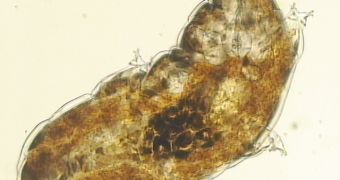Although lacking a spine and a skeleton, these are real animals and are spread all over the planet. The tardigrades (better known as water bears), famous for their sturdiness, have recently been sent on a trip to space in order to prove precisely that feature. Surprisingly, not only that they survived but they were even able to reproduce the same as if they stayed home.
I'm sure most of you believed that kitchen cockroaches were the toughest beings ever created, as the myth of their surviving an atomic war becomes more and more popular. Still, scientists have recently been on a quest to demonstrate otherwise and it seems that, with the exception of a few bacterial strains, the only living organism that ever made it naked to the skin through the universe was the Tardigrada.
It had been previously noticed that, when exposed to severe conditions such as lack of food, desiccation, extremely high or super-low temperatures (-240 to +300 degrees Fahrenheit) or vacuums, the tiny water bears halted their metabolism and survived. Even more, they were able to repair their DNA which was damaged by huge doses of radiations. The curious features made researchers want to test them directly into space.
Thus, Petra Rettberg, a microbiologist at the Institute of Aerospace Medicine was asked to design a type of container for the small eight-legged creatures. The tardigrades were then placed on the Foton-M3 satellite launched one year ago. Prior to that, the animals were forced into an anhydrobiotic state (they were dehydrated), which slowed their metabolism 10.000 times. Upon reaching the orbit, their box opened releasing them into the frozen space vacuum. Some of the water bears were only exposed to a low level of cosmic radiations while the rest had to face directly both high cosmic radiation and unfiltered solar radiation.
When they got back home, the first ones had no problem coming to life and reproducing normally, while only some of the others survived. But that is still a remarkable fact, according to Rettberg. Her colleagues are eager to discover how the tiny water bears did it and, if possible, apply this to humans, should technology allow it. Possible applications are in the hundreds: from human DNA repairs to survival adaptation for members of some off-the-Earth colonies.

 14 DAY TRIAL //
14 DAY TRIAL //